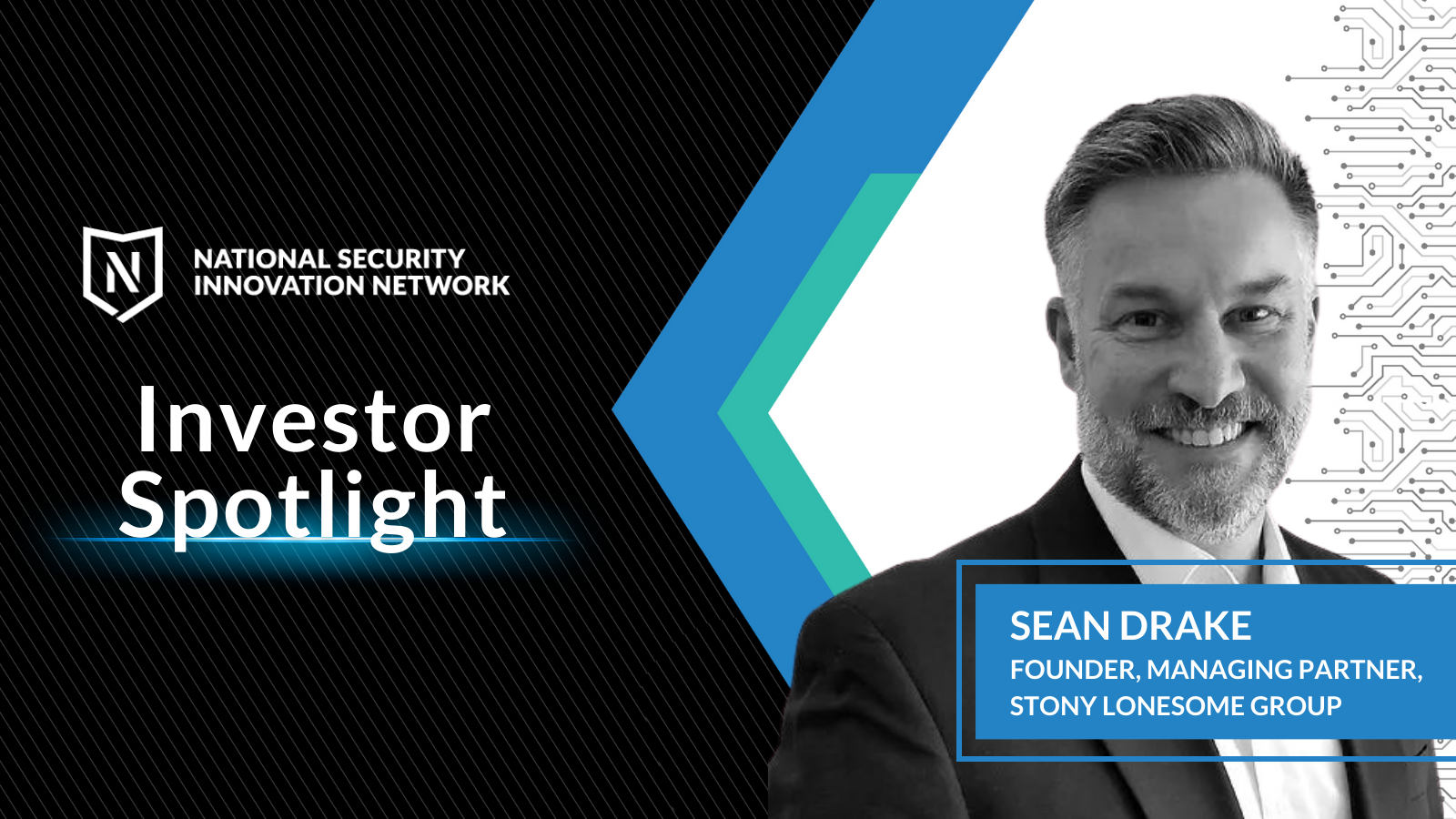
Investor Spotlight - Stony Lonesome Group

This edition of our Investor Spotlight was facilitated by Marcy Muldrow Sanders, our Regional Engagement Principal for the Florida Panhandle. Learn more about our Southeast Region and connect with Marcy, and other members of our Southeast Regional Network team at www.nsin.mil/regions/southeast/.

NAME: Sean Drake, Founder and Managing Partner
COMPANY: Stony Lonesome Group
FOUNDED: 2011
HEADQUARTERS: Tampa, FL
TECHNOLOGY VERTICALS FOCUS: Dual-Use Deep Tech, National Security and Veteran Entrepreneurship, Specifically Medtech/Healthtech, Human Performance, Veteran Care/First Responder Care, Cybersecurity, AI/ML, UAVs
PREFERRED ROUNDS: Series A to Pre-IPO
CHECK SIZE: $500,000 to $2M with potential for follow-on
LEAD PREFERENCE: Comfortable leading or syndicating rounds
NOTABLE INVESTMENTS: ID.me, Arria NLG, Cyberspatial, Hemotek, Neuroflow, Warrior Centric Health, Redactable, Target Arm, Valqari, VeriTx
Q: What excites you most about investing in dual-use and defense-focused companies?
I did five years of active duty as an Army Infantry Officer. Several of my partners at Stoney Lonesome Group (SLG) did 25-35 years of service. What I like about SLG’s dual-use, mission-focused investment thesis is that we all feel like we are still in the fight and having an impact. Whether that is bringing cutting-edge technology to the warfighter, caring for veterans and their families when they return, or mentoring a veteran as they become an entrepreneur; [service] is in our DNA.
Q: What keeps you up at night?
That we have become a nation divided and that partisan politics and petty personal agendas have been prioritized before the security, prosperity, and leadership that America is all about. In this peer-to-peer and near-peer threat environment we should be united and vigilant and be looking outward rather than fighting internally. We have lost our focus and our adversaries are taking advantage of that to spread their influence and gain an advantage.
Q: How does that inform your investment strategy?
One of SLG’s competitive advantages or our edge is the extensive background of some of our key leaders who served at the highest levels and our ability to reach back out into the DoD community to understand the gaps and the priorities around national security and critical technology requirements. We then formulate our investment thesis to source the most innovative technology, fund it, and then bring it back to the DoD. We must move at the speed of innovation, not the speed of government if we want to stay competitive in AI, cyber, autonomy and deep tech.
Q: What are some common traits you have seen in the most successful dual-use companies, in or outside your portfolio?
Entrepreneurship is hard, plain and simple. You have to be resilient and be prepared to adjust fire or even pivot when needed. Some of our best companies look very different or are addressing a very different addressable market than where we started. My favorite word in Venture is GRIT. That is one of the key reasons SLG has focused on military veteran founders…their ability to perform under pressure and get to the Ranger objective no matter what is required.
Q: How do you measure success for your portfolio?
While SLG’s mission-focused investment thesis has been at our core since our inception and while it is truly part of our DNA, we are a VC firm and we are capitalists not philanthropists. We endeavor for each fund to be a top quartile or even top decile performer in terms of cash-on-cash, multiple on invested capital (MOIC) returns. With that said, we are very patient with capital and are willing to sacrifice internal rate of return (IRR) in order to support the mission and the longer acquisition cycles required to get on real long-term contracts or program objective memorandum (POM). In the world of dual-use, you could almost say that POM is the equivalent of becoming an IPO unicorn.
Q: What do you look for in companies with medtech, healthtech, veteran care, and first responder care that changes the game?
That is a pretty broad area, but what I will say is that one of the things at SLG that we are especially proud of is our track record of investing in companies impacting behavioral health, post-traumatic stress disorder (PTSD) and veteran suicide challenges that are common priorities across both the DoD and first responder communities. We have made close to 10 investments in this sector to include some real game changers like Neuroflow, CAD Therapeutics, and Nightware.
Q: In the Southeast region venture capital companies tend to be located in major metropolitan areas. What advice would you give to start-ups seeking funding outside of these areas?
SLG has typically invested nationally due to the broad reach of the entire Stony Lonesome “Group”. That being said, relocating our headquarters to Tampa in 2021 was definitely the right move with our dual-use investment focus. Being closer to MacDill Air Force Base and SOFWERX, and with Special Operations Command (SOCOM) and U.S. Central Command (CENTCOM) as early adopters of the tech we invest in, it has been a great ecosystem. We have a very strong concentration in the D.C. Beltway, several companies in North Carolina, and have seven portfolio companies and growing based in Florida. My biggest advice would be to attend networking opportunities in the region to meet the end users and understand their requirements.
Q: What made you invest in ID.me? Is there a lesson in that start-up that other start-ups could learn from?
When look across our portfolio companies and do our own internal after action review on our investment track record, one of the consistent traits that has differentiated our best performers is that, in addition to having great tech and a focus on pleasing their customers, the best leaders like Blake Hall at ID.me, Chris Molaro at Neuroflow, or Ron Steptoe at Warrior Centric Health also focus on developing their key junior leaders and building a great culture. As they say, culture eats strategy every time. I think too many times entrepreneurs get overly focused on their own technology and do not put enough emphasis on mentoring and developing their talent internally.
Q: What advice would you give to the DoD to foster entrepreneurship and commercialization of technology, especially in the Southeast region?
They have to reduce the friction in the acquisitions cycle and recognize that what works for building aircraft carriers and tanks is not going to work in the fast-moving and dynamic arenas of cyber, AI and autonomy. Even more importantly, the government has to learn to buy/ purchase/ acquire technology and not just hire or award contracts to services-oriented contractors who claim they can “build it themselves” with butts in seats mentality. The DoD is notorious for taking three times longer and two times the money to try to build technology that is better and already available from the innovation coming out of the private sector. I will say we are getting better, but we still have a long way to go to move at the speed of innovation!